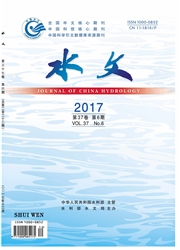

 中文摘要:
中文摘要:
为了克服目前对标准化降水指数(SPI)计算必须首先假设服从某种分布的不足,依据最大熵理论分布对SPI进行计算,以东江流域为例,分别利用最大熵理论分布、Gamma分布、Weibull分布以及对数正态分布四种概率密度函数拟合多年不同时间尺度的降雨数据,并利用AIC、KS、AD法进行拟合度检验,最后将最大熵理论分布与Gamma分布计算的SPI结果进行对比分析。结果表明:相对于其他三种分布,最大熵理论分布的概率密度函数更适用于东江流域15个站点的3、6、12个月的降雨分布;在极端干旱(洪涝)的情况下,相对于Gamma分布,最大熵理论分布的SPI值更小(大),表明其对极端干旱(洪涝)的识别更为敏感。
 英文摘要:
英文摘要:
In order to fill in the gaps of the current standardized precipitation index(SPI) obeying a certain distribution, the SPI index was calculated according to the distribution of the maximum entropy theory. Taking the Dongjiang River Basin as a study case, the theory of maximum entropy distribution, Gamma distribution, Weibull distribution and lognormal distribution probability density function were used to fit for different time scales of precipitation data respectively. And AIC, KS, AD were used to test the results of fit goodness. The calculation of SPI with the maximum entropy theory and the Gamma distribution were comparatively analyzed. The results show that: when being compared with other three kinds of distribution, the distribution of the maximum entropy theory probability density function fits better for 3,6, 12 months of precipitation data from 15 stations in the Dongjiang River Basin; in the case of extreme drought(flood), relative to the Gamma distribution, the SPI calculated with the distribution of the maximum entropy theory is smaller(larger), which suggests that the distribution of the maximum entropy theory is more sensitive to deal with the extreme drought(flood).
 同期刊论文项目
同期刊论文项目
 同项目期刊论文
同项目期刊论文
 期刊信息
期刊信息
